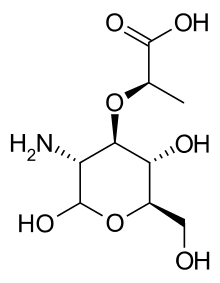Muramic acid  |
| Names |
Preferred IUPAC name 2-[3-Amino-2,5-dihydroxy-6-(hydroxymethyl)oxan-4-yl]oxypropanoic acid |
Systematic IUPAC name 2-{[3-Amino-2,5-dihydroxy-6-(hydroxymethyl)oxan-4-yl]oxy}propanoic acid |
| Identifiers |
| | |
3D model (JSmol) | |
| 3DMet | |
| | 2334586 |
| ChEBI | |
| ChemSpider | |
| ECHA InfoCard | 100.012.923  |
| EC Number | |
| KEGG | |
| | - 441038 (2R),(3R,4R,5S,6R)
- 12313001 ,(3R,4R,5S,6R)
- 44123550 (2R),(2R,4R,6R)
- 45039974 (2R),
- 433580
|
| UNII | |
InChI=1S/C9H17NO7/c1-3(8(13)14)16-7-5(10)9(15)17-4(2-11)6(7)12/h3-7,9,11-12,15H,2,10H2,1H3,(H,13,14)/t3-,4-,5-,6-,7-,9-/m1/s1  Key: MSFSPUZXLOGKHJ-KTZFPWNASA-N 
|
SMILES CC(OC1C(N)C(O)OC(CO)C1O)C(O)=O
|
| Properties |
Chemical formula | C9H17NO7 |
| Molar mass | 251.23378 |
Except where otherwise noted, data are given for materials in their standard state (at 25 °C [77 °F], 100 kPa). |
| | |
Muramic acid is an amino sugar acid. In terms of chemical composition, it is the ether of lactic acid and glucosamine. It occurs naturally as N-acetylmuramic acid in peptidoglycan, whose primary function is a structural component of many typical bacterial cell walls.[1].
References
This article is copied from an
article on Wikipedia® - the free encyclopedia created and edited by its online user community. The text was not checked or edited by anyone on our staff. Although the vast majority of Wikipedia® encyclopedia articles provide accurate and timely information, please do not assume the accuracy of any particular article. This article is distributed under the terms of
GNU Free Documentation License.
All content on this website, including dictionary, thesaurus, literature, geography, and other reference data is for informational purposes only. This information should not be considered complete, up to date, and is not intended to be used in place of a visit, consultation, or advice of a legal, medical, or any other professional.
